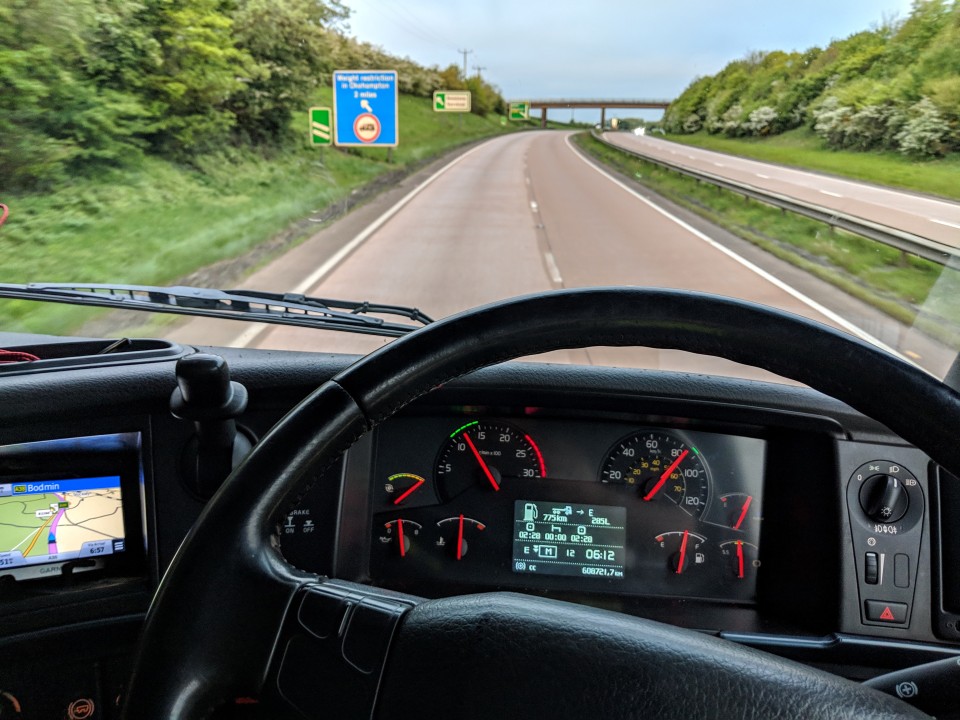
Susie Jones
Zjednodušenie pravidiel pre tachografy
Vytvorené: 01. 08. 2024
•
Aktualizované: 08. 08. 2024
Svet pravidiel tachografov môže byť mätúci aj pre najskúsenejšieho vodiča nákladného vozidla. A čo už nehovoriac o nováčikoch, ktorí vstupujú do tohto odvetvia. Naším cieľom je objasniť niektoré z týchto nejasností.
Čo je tachograf a prečo ho máme?
Podľa slovníka je tachograf "zariadenie, ktoré sa umiestňuje do vozidiel, ako sú nákladné autá a autobusy, s cieľom zaznamenávať informácie, ako napríklad rýchlosť vozidla, vzdialenosť, ktorú prejde, a počet prestávok, ktoré vodič urobí."
Účelom tachografu je predchádzať únave vodičov a zabezpečiť, aby vodiči a zamestnávatelia dodržiavali predpisy. Charitatívna organizácia Brake, ktorá sa zaoberá bezpečnosťou cestnej premávky uviedla, že "štyri z desiatich nehôd spôsobených únavou sa týkajú osoby, ktorá riadi úžitkové vozidlo". Preto pravidlá pre tachografy zohrávajú dôležitú úlohu pri snahe o zníženie tohto počtu.
Kedy potrebujete tachograf?
Tachograf musíte mať, ak celková hmotnosť vášho vozidla presahuje tri a pol tony. Je dôležité si uvedomiť, že to zahŕňa aj ťahanie prívesu. Z tohto pravidla existuje niekoľko výnimiek:
Ak jazdíte len mimo verejných ciest
Ak vozidlo riadia ozbrojené sily, polícia alebo hasiči
Ak patríte do komerčného vozového parku a používate vozidlá s maximálnou hmotnosťou sedem a pol tony a vaša cesta je vzdialená menej ako 100 km od vašej prevádzkovej základne.
Ak prevážate tovar a vaše vozidlo je elektrické
Ak prevážate zariadenie alebo stroje pre potreby vodiča a riadenie tohto vozidla nie je vašou hlavnou pracovnou činnosťou.
Aké sú rôzne typy tachografov?
Existujú tri rôzne typy tachografov:
Analóg: Tieto boli v Európe povinné od roku 1986. Analógové tachografy používajú na zaznamenávanie údajov vodiča listy voskového papiera. Vodiči údaje zadávajú ručne a vkladajú ich do tachografu.
Digitálne: Tieto boli zavedené v roku 2006. Používa ich viac ako milión dopravných spoločností a viac ako šesť miliónov profesionálnych vodičov. Digitálne tachografy zaznamenávajú údaje vodiča na interné pamäťové zariadenie a kartu vodiča.
Inteligentné: Európska únia od júna 2019 nariadila, aby spoločnosti používali inteligentné tachografy. Tie automaticky zaznamenávajú polohu vozidla na začiatku a na konci každej jazdy. Každé tri hodiny poskytujú aj aktualizácie
Čo znamenajú jednotlivé symboly tachografu?
Pozrite si naše video, ktoré vysvetľuje jednotlivé symboly tachografu.
Porušenie pravidiel
V záujme bezpečnosti vodiča nákladného vozidla a všetkých ostatných účastníkov cestnej premávky je potrebné dodržiavať pravidlá prestávok. Rozdelili sme kľúčové body.
Čas jazdy:
- Môže byť maximálne štyri a pol hodiny pred prestávkou
Prestávky:
- Musia trvať aspoň 45 minút, pokiaľ si vodič nevyberie prestávku na odpočinok
Doba odpočinku:
- Počas doby odpočinku nie je možné viesť vozidlo alebo vykonávať inú prácu
Delenie prestávok:
Celá 45-minútová prestávka môže byť rozdelená na 15-minútovú prestávku, po ktorej nasleduje 30-minútová prestávka
Delené prestávky sa musia rozdeliť na štyri a pol hodiny jazdy
Podľa pravidiel EÚ, ak sú prestávky rozdelené, druhá prestávka musí trvať aspoň 30 minút.

Denný limit jazdy
Denný limit jazdy sa vzťahuje na maximálny čas jazdy za deň. Maximálny čas je deväť hodín, ale je možné ho zvýšiť na desať. Nie je to však možné urobiť viac ako dvakrát za stanovený týždeň. Denný čas jazdy možno definovať ako:
Celkový akumulovaný čas jazdy medzi koncom denného odpočinku a začiatkom nasledujúceho denného odpočinku
Celkový akumulovaný čas jazdy medzi denným odpočinkom a týždenným odpočinkom. .
Týždenný a dvojtýždenný limit jazdy
Vodiči musia dbať na to, aby neprekročili maximálny týždenný a dvojtýždňový limit jazdy.
Maximálny týždenný limit na vedenie vozidla je 56 hodín (platí pre pevný týždeň)
Pevný týždeň sa začína o 00.00 hod. a končí o 24.00 hod. nasledujúcu nedeľu
Dvojtýždňový limit jazdy je 90 hodín.
Denný odpočinok
Okrem toho je potrebné denne odpočívať.
Vodič musí nepretržite odpočívať 11 hodín. Tento počet môže byť skrátený na deväť
K tomuto zníženiu môže dôjsť len trikrát medzi týždennými obdobiami odpočinku
Doba odpočinku sa musí ukončiť do 24 hodín po skončení poslednej dennej alebo týždennej doby odpočinku.
Denný odpočinok je možné absolvovať vo vozidle, je však potrebné mať vhodné priestory na spanie. Ak tieto zariadenia chýbajú, vodič si musí nájsť ubytovanie. Pozrite si našu stránku miesta a zistite, ktoré zastávky pre kamióny túto službu ponúkajú.
Týždenný odpočinok
Týždenný odpočinok sa musí čerpať najneskôr na konci šiestich po sebe nasledujúcich 24-hodinových období od konca posledného týždenného odpočinku.
Vodiči sú povinní odpočívať najmenej 45 hodín
Môžu mať skrátený týždenný odpočinok v trvaní najmenej 24 hodín
Skrátený týždenný odpočinok je potrebné kompenzovať v jednom bloku, a to najmenej deväť hodín pred koncom tretieho týždňa.
Hoci je možné čerpať skrátený odpočinok, je potrebné si uvedomiť, že počas dvoch po sebe nasledujúcich týždňov, keď bol čerpaný skrátený odpočinok, musí jeden z nich trvať 45 hodín.

Viacčlenná posádka
Niektorí vodiči môžu vziať na palubu ďalšieho vodiča. Medzi výhody patrí vyššia produktivita, vyšší počet najazdených kilometrov a dlhší čas jazdy.
Obaja vodiči musia denne odpočívať deväť hodín
Tento denný odpočinok sa musí vykonať v priebehu 30 hodín a nie 24 hodín.
Prvá hodina viacčlennej posádky si nevyžaduje ďalšieho vodiča. Po jednej hodine sa stáva povinným.
Prechody trajektom alebo cesty vlakom
Ako je uvedené vyššie, pravidelný denný odpočinok vodiča musí trvať nepretržite 11 hodín, avšak z tohto pravidla existuje niekoľko výnimiek. Za predpokladu, že vozidlo sprevádza vodič; denný odpočinok môže byť prerušený dvakrát, ale nesmie presiahnuť celkovo jednu hodinu. Napríklad nastupovanie a vystupovanie na trajektoch a vo vlakoch.
Ak sa takto preruší pravidelný denný odpočinok, musí byť kumulovaný odpočinok aspoň 11 hodín alebo 12 hodín, ak je rozdelený.
Čo je pravidlo jednej minúty pre tachograf?
Pravidlo jednej minúty vstúpilo do platnosti v októbri 2011. Odkazuje na staršie právne predpisy, ktoré podrobne stanovovali, že minúta s najmenej piatimi sekundami jazdy sa musí zaznamenať ako čas jazdy. EÚ však túto legislatívu zmenila tak, že jedna najdlhšia nepretržitá činnosť vykonaná v rámci minúty sa zaznamená na základe tejto konkrétnej činnosti.
Čo by sa stalo, keby som nedodržal pravidlá tachografu?
Nedodržanie pravidiel pre tachografy môže mať za následok pokutu a niekedy aj trest odňatia slobody. Vo všeobecnosti trest závisí od závažnosti porušenia. Väčšina porušení pravidiel tachografu sa rieši pevne stanovenými pokutami. Vodiči majú na zváženie pevných pokút až 28 dní.
V Spojenom kráľovstve existujú dva druhy pokút a sankcií.
Pokuta štvrtej úrovne: je obmedzená na 2 500 GBP; tento limit sa vzťahuje na každú pokutu za tachograf. V prípadoch s viacerými porušeniami štvrtej úrovne však môže byť uložená maximálna pokuta za každé porušenie.
Pokuta piatej úrovne: je obmedzená na 5 000 libier, avšak podobne ako pri pokutách štvrtej úrovne, v prípadoch viacnásobného porušenia môže byť uložená maximálna pokuta.
Pravidlá tachografu môžu byť zložité na pochopenie. Ich nedodržiavanie však môže viesť k bezpečnostným problémom a potenciálnym pokutám. Pochopením a dodržiavaním pravidiel môžu vozové parky a vodiči prevádzkovať svoje vozidlá bezpečne a legálne. Je veľmi dôležité si uvedomiť, že pravidlá a predpisy týkajúce sa tachografov sa môžu v jednotlivých krajinách líšiť.



